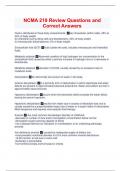Exam (elaborations)
NCMA 219 Review Questions and Correct Answers
- Course
- Institution
Fluid is distributed in three body compartments: (a) intracellular (within cells), 35% to 40% of body weight (b) interstitial (surrounding cells and bloodstream), 20% of body weight. (c) intravascular (blood plasma), 5% of body weight. Extracellular fluid (ECF) fluid outside the cells; includes in...
[Show more]



